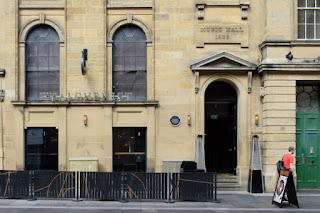Built in the 1830's Nelson Street is a short street off the north end of Grainger Street and is part of Graingertown. The street was named after a great man who did not hail from the North East - Admiral Lord Horatio Nelson, naval hero of the 1805 Battle of Trafalgar.
It was home to an 1800s music hall where, notably, Charles Dickens read from a selection of his greatest novels in 1861.
1st August 2022


Nelson Street, no's. 2 to 6.
Shops and houses, now shops. Circa 1836, probably by John Wardle, for Richard Grainger. Sandstone ashlar; Welsh slate roof. 3 storeys, with 4 at right; 8 bays.
Ground floor altered. 2 right bays of 4 storeys have architraves to windows on tipper floors, with frieze and cornice above first-floor windows and bracketed sills to second floor, under entablature with prominent bracketed cornice. Top floor has sashes in plain reveals under cornice and blocking course. 6 recessed bays at left have first-floor aproned sills, second-floor sill string all sashes in plain reveals, some with glazing bars. First floor band to these bays; top cornice and blocking course. Later wrought iron gate in first bay.
Grade 2 Listed. Source: Sitelines.

Nelson Street, no's 7 to 9.







Nelson Street, no. 8.
House and shop, now shop. Circa 1836, probably by John Wardle, for Richard Grainger. Sandstone ashlar with later pink granite and terra-cotta columns to shop; roof not visible. 3 storeys, 5 bays.
Central renewed double door under swan-neck pediment, with keyed roundel and garlands, recessed between tall shop windows with slender glazing bars; Jacobean-style columns flank door.
Rusticated pilasters define end bays containing 6-panelled double doors and high overlights with patterned glazing bars.
Ground floor fascia and cornice. First floor sill string to sashes in architraves, the central with blind balustrade and bracketed pediment, the outer bays with cornices. Second-floor architraves have bracketed sills. All windows have glazing bars. Bracketed top cornice and balustrade. This building has been redeveloped behind the facade, so only the facade is of interest.
Grade 2 Listed. Source: Sitelines.





Nelson Street, no's. 10 and 12, music hall.
Built in 1838, it replaced that previously built by Grainger in Blackett Street. It held lectures (by leading orators of the day, notably Charles Dickens and Dr. John Hunter Rutherford, the Scottish evangelist, doctor of medicine, educationalist and friend of the poor and disadvantaged), exhibitions and classical music concerts.
In 1879 it became the New Tyne Concert Hall. In 1884 Horace Edward Moss bought the property. The Moss Empire chain also owned the Gaiety Theatre in Edinburgh and the Theatre Royal in Sunderland. Moss turned the Nelson Street music hall into the Gaiety Variety Theatre. The interior was decorated by Herr Svelder and Messrs. Dobie of Edinburgh. The Gaiety became known as the "Eldorado of the North". By 1890 it became obvious that the theatre was too small, and the Empire Theatre was opened in Newgate Street.
Sandstone ashlar, 3 storeys. Steps up to 6-panelled door in round-arched surround. Panel over door incised MUSIC HALL 1838. The building has been redeveloped behind the façade so only the façade is of interest.
Grade 2 Listed. Source: Sitelines.






Nelson Street, no. 12a.
Warehouse, now facade of Eldon Centre shopping precinct. Circa 1899 by Marshall and Tweedy. Sandstone ashlar. Roof not visible. Free Baroque style. 4 storeys and attics; 5 bays.
Ground floor has Ionic pilasters flanking renewed windows and recessed entrances, under bracketed fascia. Brackets support slender pilasters extending 2 ½ storeys defining bays and having cartouche finials. 2-storey bracketed oriels in outer bays; and all other windows have slender wood mullions and transoms; top windows have 2-storey keyed architraves to inner bays, outer segmental-headed architraves. Modillioned eaves cornice; parapet with 3 segmental headed attics windows. This building has been redeveloped behind the facade so that only the facade is of interest.
Grade 2 Listed. Source: Sitelines.



Nelson Street, no. 14, Dispensary.
The Newcastle Dispensary opened at 14 Nelson Street in 1839 having previously been located in The Side from 1777 to 1790 and in Low Friar Street from 1790 to 1838. The premises later became the Fruit Exchange. Sandstone ashlar, 3 storeys. Central panelled door flanked by pilasters. Upper floors have sah windows with glazing bars. The building has been developed behind the façade so that only the façade is of interest.
Grade 2 Listed. Source: Sitelines.



Nelson Street, no's. 16 to 22, Cordwainer's Hall.
House and shop, now shop. Circa 1836, probably by John Wardle, for Richard Grainger. Sandstone ashlar with later pink granite and terra-cotta columns to shop; roof not visible. 3 storeys, 5 bays.
Central renewed double door under swan-neck pediment, with keyed roundel and garlands, recessed between tall shop windows with slender glazing bars; Jacobean-style columns flank door. Rusticated pilasters define end bays containing 6-panelled double doors and high overlights with patterned glazing bars.
Ground floor fascia and cornice. First floor sill string to sashes in architraves, the central with blind balustrade and bracketed pediment, the outer bays with cornices. Second-floor architraves have bracketed sills. All windows have glazing bars. Bracketed top cornice and balustrade. This building has been redeveloped behind the facade, so only the facade is of interest.
Grade 2 Listed. Source: Sitelines.






18th July 2018
Nelson Street, no's. 10 and 12, music hall.
Nelson Street, no. 8.
Nelson Street, no's. 16 to 22, Cordwainer's Hall.
Nelson Street, no. 14, Dispensary.
Nelson Street, no. 12A.
25th December 2013
More Information:
- CoCurate, Nelson Street
- Co-Curate, Cordwainers Hall
- Sitelines, Nelson Street, no's. 1 to 37
- Sitelines, Nelson Street, no's. 2 to 6
- Genuki, The Nelson Street 'Music Hall' of 1838
- Sitelines, Nelson Street, Primitive Methodist Chapel
See my other photos around Nelson Street:




















.jpg)
No comments:
Post a Comment